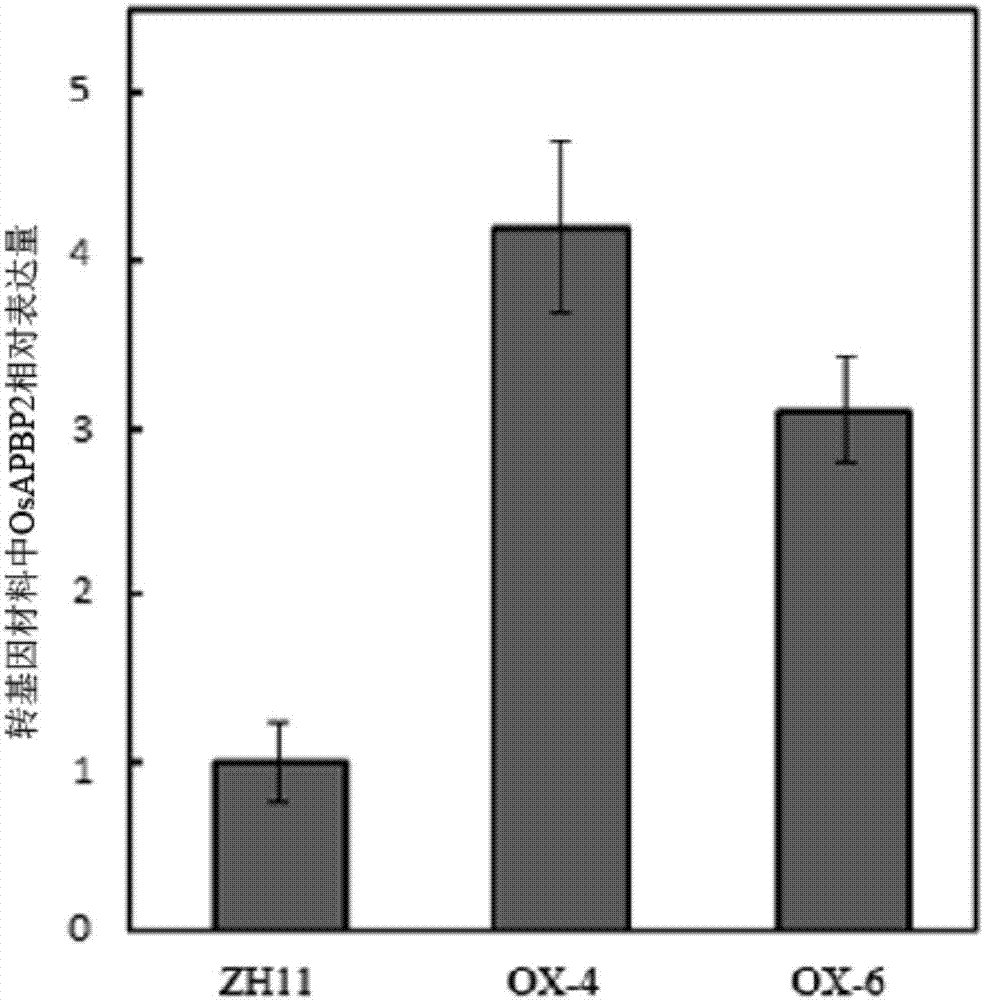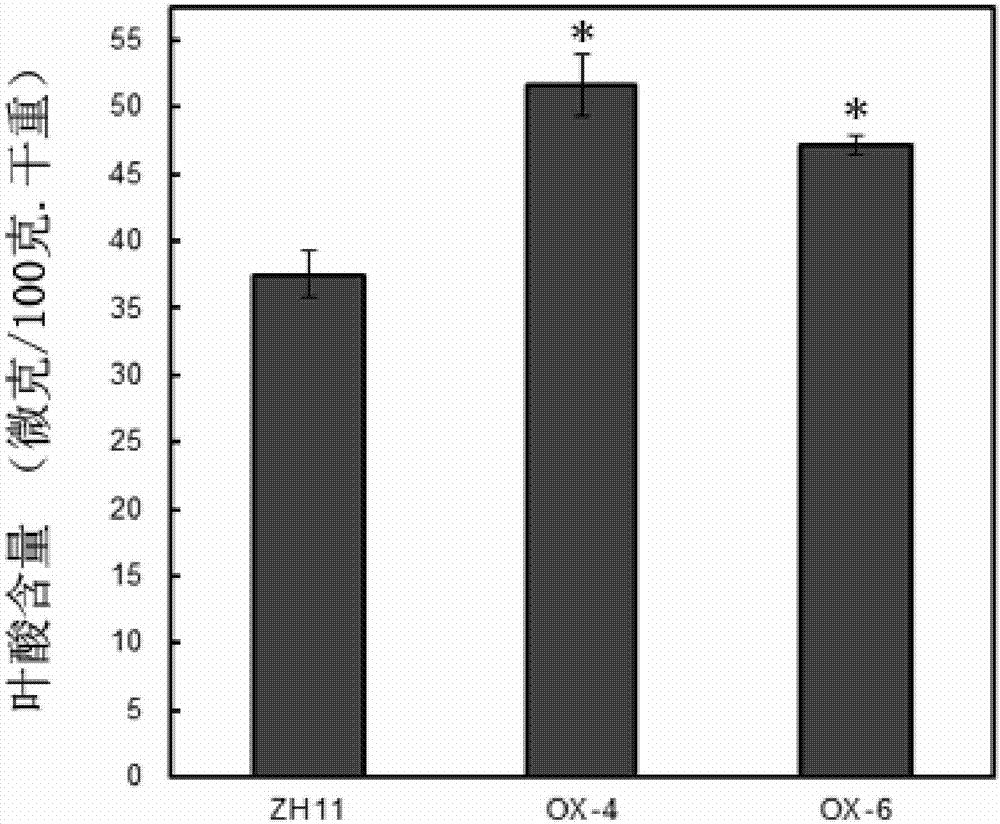Application of OsAPBP2 protein to promotion of synthesis of plant folic acid
A folic acid and plant technology, applied in the biological field, can solve the problems of insufficient substrates of folic acid synthesis and metabolism, and folic acid metabolism disorder.
- Summary
- Abstract
- Description
- Claims
- Application Information
AI Technical Summary
Problems solved by technology
Method used
Image
Examples
Embodiment 1
[0070] Embodiment 1, the preparation of turning OsAPBP2 rice
[0071] 1. Construction of OsAPBP2 plant overexpression vector
[0072] (1) Genomic DNA of rice Zhonghua 11 was extracted.
[0073] (2) Design and synthesize the following primers (the underlined sequence is the enzyme recognition site):
[0074] Upstream primer: 5'-GC TCTAGA ACCATGTGCGGCGGAGCAATCATC-3';
[0075] Downstream primer: 5'-AT GTC GAC GTAGGCACCAGCTGCCATGA-3'.
[0076] (3) Using the genomic DNA in step (1) as a template and using the upstream primer and downstream primer in step (2) as primers to perform PCR amplification to obtain the OsAPBP2 gene.
[0077] (4) Use Xba I and Sal I to double digest the PCR product obtained in step (3) to obtain a gene fragment; Xba I and SalI to double digest pCAMBIA1307 to obtain a large vector fragment; connect the gene fragment to a large vector fragment to obtain a recombinant Plasmid, named as pCAMBIA1307-OsAPBP2, pCAMBIA1307-OsAPBP2 structure diagram as shown...
Embodiment 2
[0095] Example 2, detection of folic acid content in trans OsAPBP2 rice
[0096]1. Select the seeds of T3 generation OsAPBP2-transformed rice and wild-type rice Zhonghua 11, grind them into powder, and store them at 4°C for later use.
[0097] 2. Dilute 1 mg / ml folic acid solution with folic acid extraction buffer to standard solutions with concentrations of 100 ng / ml, 50 ng / ml, 20 ng / ml, 10 ng / ml, 5 ng / ml, and 1 ng / ml.
[0098] The folic acid extraction buffer is a solution obtained by mixing vitamin C sodium salt (sigma A7631) with 5mM phosphate buffer, wherein the mass fraction of vitamin C sodium salt in the folic acid extraction buffer is 1%. The formula of 5mM phosphate buffer is as follows: NaH 2 PO 4 (sigma, 17844) 0.419g / L, Na 2 HPO 4 2H 2 O (sigma, 71633) 0.269g / L, pH 6.0-6.5.
[0099] 3. Take 300 μl of folic acid solutions of different concentrations obtained in step 2, cook in boiling water for 10 minutes, cool on ice for 10 minutes, and mix well. Add 100 μl...
Embodiment 3
[0105] Example 3, Detection of expression levels of key folic acid synthesis genes in rice transfected with OsAPBP2
[0106] 1. The leaves of 3-week-old T3 transgenic OsAPBP2 rice and wild-type rice Zhonghua 11 were selected, washed with water, and the excess water was blotted with absorbent paper, then quickly frozen with liquid nitrogen and stored at -80°C.
[0107] 2. Take about 0.1 g of leaves, quickly grind them into powder with liquid nitrogen, add 1 ml of TRIZOL (Invitrogen, product number 15596026) to extract total RNA according to the instructions.
[0108] 3. Use a reverse transcription kit (TaKaRa, catalog number: DRR014A) to reverse transcribe the RNA obtained in step 2 into cDNA.
[0109] 4. Carry out quantitative PCR using the cDNA in step 3 as a template to detect the expression levels of key genes OsGDPCHI, OsDHNA, OsADCS, OsADCL, OsDHFR1, OsDHFR2 and OsFPGS1 in rice folic acid synthesis, and analyze the regulatory effect of OsAPBP2 protein on key genes of foli...
PUM
 Login to View More
Login to View More Abstract
Description
Claims
Application Information
 Login to View More
Login to View More - R&D
- Intellectual Property
- Life Sciences
- Materials
- Tech Scout
- Unparalleled Data Quality
- Higher Quality Content
- 60% Fewer Hallucinations
Browse by: Latest US Patents, China's latest patents, Technical Efficacy Thesaurus, Application Domain, Technology Topic, Popular Technical Reports.
© 2025 PatSnap. All rights reserved.Legal|Privacy policy|Modern Slavery Act Transparency Statement|Sitemap|About US| Contact US: help@patsnap.com



